Any long-time SparkFun reader may know that we really enjoy writing about the wacky legal entanglements we've experienced, whether it’s cease-and-desist letters from Sparc International, tossing out 4,000 DMMs, or dealing with counterfeit ICs. Unfortunately, now it’s time we talk about patent trolls.
Since a few of my international friends looked at me funny when I mentioned it, a patent troll is a company that is specifically set up to purchase the rights to a handful of patents and then sue anyone they feel they can get money from.
Patent trolls are Americans that are destroying American manufacturing and small business. I've got heaps of challenges when it comes to SparkFun, but patent trolls are what keep me up at night. SparkFun knows how to manufacture in America, and we've created tons of new open source products, but patent trolls can come out of nowhere and do real harm. It's legalized extortion. There’s a few forms of this so let’s first talk about ransoming. SparkFun has received a few of these over the years. Let’s have a look at a passive one from Feinberg Day:
An almost nice ransoming from Feinberg Day
Sal is basically saying, "Hey there. We noticed you have a website. We have patents that deal with websites. We’ve managed to (supposedly) shake-down Foot Locker and Northern Tool. You should probably call us to discuss this.”
It’s sort of like scam phone calls. If you answer your phone at all, they know there’s a human there and your phone number is now more valuable to other scammers. If you actually call Sal, they’ll know you’re paying attention and worried. We're not an attorney but we found the best solution to this type of troll is to ignore it.
Say it with me: RazDog!
RazDog takes it up a notch. Sorry, but I just can’t take RazDog seriously. Just saying "RazDog" makes me giggle. But in this type of patent ransoming they put in a ticking clock. If you respond in two weeks it’s $49,284. If you delay it’s $54,284, so you’d better call now! Again, we're not an attorney but we found the best solution is to ignore it.
If you ever find yourself down the rabbit hole of patent trolls you will likely never find the bottom. Gag orders are used thoroughly by trolls to prevent anyone from talking about settlements. So if you never hear from us again you'll know it's because we had to adhere to a gag order.
Not what you want to read on a Monday morning
Which brings us to Monday morning. My good friend, who happens to be a powerhouse of a trademark attorney, sent me the above text message. She is super nice and I think has some alerts for SparkFun in place so she can keep an eye out for me. She was letting me know we were being sued by someone called Altair Logix. More on them in a minute but I’d like to point out that:
- As of Wednesday, June 30th, we have not received any paperwork or been notified of the lawsuit.
- I’ve already received two spam emails from unknown law firms letting me know I’m being sued and wanting to represent me.
So imagine you’re a small business that designs and manufactures stuff, and you start being told you’re being sued. You’ve got to focus on building things, keeping the lights on, and keeping people employed. It’s terrifying. In fact, I’m still paranoid about even writing this blog post. We’re really poking a stick at Feinberg, RazDog and Altair Logix here. These firms could potentially bring a tremendous amount of pain against SparkFun. But we think it's far more important to pull back the curtain on questionable and unethical business practices. Let’s return to Altair Logix.
Altair Logix is located in Frisco, Texas. Texas and patent trolls immediately remind me of the excellent This American Life episode “When Patents Attack.” It’s a great listen and goes far more in depth on the overall patent troll issue. This entity I'm now calling Al doesn’t seem to build anything. They don’t really do R&D. I’m hard pressed to even locate a website or contact information for Al. But Al does seem to enjoy suing people: Texas Instruments, Coolpad Technologies, VIA Technologies, Renesas, ASUS, Caterpillar, Nuvision International, Netgear, Lynx Innovation, … oh my! Let’s add SparkFun to that list of people being sued.
Altair Logix v. SparkFun
Al is claiming that they have patent number 6289434 which they quickly start referring to as patent ‘434. Can I tell you how humorous it is that an attorney feels it necessary to shorten a 7-digit number to a 4-character abbreviation? Thanks Al. That really saves me some time.
Patent US6289434
Patent 6289434 was written in 1998 and granted in 2001. I’ll start by pointing out that patents are valid for 20 years from the date on which the application for the patent was filed, so 2018, but I’m no patent attorney. You are welcome to read all 93 pages of it, but it’s laughable. I don’t know the original authors Rupan Roy or the Cognigine Corporation; perhaps they thought that a "Media Processing Unit" was really novel in 1998. Today, it’s not.
Make-believe Media Processing Unit
There’s lots of official looking diagrams in this patent. If you ignore the fancy "media processor" jargon, the image above shows a multi-core processor. These are not telling or descriptive or even helpful diagrams; they are fluff.
An SPI Interaction made to look official
Oh look! It’s a diagram of an SPI interaction with interrupts! (If this doesn’t make sense to you, just know that SPI transfers move data between your SD card and anything that uses an SD card - they are omnipresent).
There is no such thing as a MAU
The goal of patent 6289434 is to take something the embedded systems industry is built on (in this case ALUs or Arithmetic Logic Unit) and change the terminology so that it’s “new.” In the above image the ALU that we use all the time is coupled with something called a MAU, which I don’t even have the time to decrypt the meaning of. It’s bullshit. MAUs don’t exist. The mixup of jargon is meant to be thick and confusing so that people who have less technical experience get worried. Why hire lots of expensive lawyers and field experts to fight when I could just settle and get back to building things? Because that only makes more little trolls.
The Altair Logix v Sparkfun Lawsuit
Let’s move on to the lawsuit. The fun starts around page 6. Al claims:
The cost is further reduced by employing only static or dynamic ram as a means for holding the state of the system. This invention provides a way for effectively adapting the configuration of the circuit to varying input data and processing requirements. (Id. at col. 3:6-8). All of this reconfiguration can take place dynamically in run-time without any degradation of performance over fixed-function implementations. (Id. at col. 3:8-11).
Dynamic ram? Can I poke fun at them for not knowing what RAM is? Yes I can.
The above paragraph succinctly describes malloc(), which is perhaps one of the most fundamental advancements in modern computing. The problem is that Al didn’t invent it. Memory management (the ability to take RAM and then give it back when your function is done) goes back to the dawn of computing. The use of malloc() and carefully tending to your RAM is pervasive in embedded systems. I literally just wrote a routine this morning for the ESP32 that throttles Bluetooth traffic because my heap was running out of space. They got a patent on memory allocation? Yeah. Sure they did.
The present invention is therefore an apparatus for adaptively dynamically reconfiguring groups of computations and storage elements in run-time to process multiple separate streams of data and control at varying rates. (Id. at col. 3:14-18). The ‘434 patent refers to the aggregate of the dynamically reconfigurable computational and storage elements as a “media processing unit.”
Once you get over the words that have obviously not been written by an embedded engineer, the lawsuit is describing variable length arrays. You can slap your “media processing unit” sticker all over it, but it’s just a malloc() call.
- Direct Infringement. Upon information and belief, Defendant has been directly infringing claim of the ‘434 patent in Colorado, and elsewhere in the United States, by making, using, selling, and/or offering for sale an apparatus for processing data for media processing that satisfies each and every limitation of claim 1, including without limitation the Sparkfun’s sale of the pcDuino Acadia Dev Board (“Accused Instrumentality”). (E.g., http://web.archive.org/web/20160909142123/https://www.sparkfun.com/products/13610).
Wait wait wait. You’re suing us over the pcDuino from 2016? We stopped selling that board in 2017. It was a neat little single board computer for its time, but why do they pick pcDuino? I suspect it has something to do with Al's previous wins against companies unfortunate enough to use a processor that used the term ‘media’ in their datasheets. Or perhaps it was the approximate date that web.archive.org had data on SparkFun’s website. The Web Archive date is conveniently before 2018 when the patent should have expired.
Can I also just say how amazing the Web Archive is? Their Wayback Machine is incredibly fun, but their mission and what they are attempting to preserve is critical for future generations to understand how our digital world changed over time. The fact that Al is using them is just tainting a good cause.
- Plaintiff has been damaged as a result of Defendant’s infringing conduct. Defendant is thus liable to Plaintiff for damages in an amount that adequately compensates Plaintiff for such Defendant’s infringement of the ‘434 patent, i.e., in an amount that by law cannot be less than would constitute a reasonable royalty for the use of the patented technology, together with interest and costs as fixed by this Court under 35 U.S.C. § 284.
So what does Al want? If patent 6289434 is to be found legitimate (which it is not), they want royalties. Now, there is something to be said here about what I call the "American Patent Dream." It goes something like this:
- I come up with a half baked idea and used some word salad no one has used before.
- I patent that idea.
- I never have to lift a finger and just enjoy cashing my royalty checks from the beach.
You can see the flaws. I am a big believer in Open Source Hardware, but I do not believe that the entire patent system is trash. If SparkFun was infringing on actual IP, from a company that was actually building something, I would work very hard to not step on their toes. Al is not building anything. They just want to sit on their beach in Texas.
We’ve sold 221 units over the entire time we carried the pcDuino. You want to sue us for $500 worth of made-up royalties to use your bogus patent? Sure. Come get it.
What can you do about patent trolls?
Talk about it if you can. We are not the only small business that has to deal with this but we are in a rare situation where we may be able to talk about it. If you have been sued or received a ransom letter, talk about it! Trolls win when we're too scared to talk.
Email your representatives. Senators and Congress people do listen to the communication they receive. Email your governor. I'm lucky to have Governor Polis who is a big supporter of patent reform and fights against patent trolls. Let them know that patent trolls are Americans that are destroying American manufacturing and small business. Trolls are terrible for the economy, destroy jobs, gum up the judicial system, and hinder innovation.
Work with smarter people than me. Tell your politician to listen to and work with groups like the EFF and Patent Progress, who have spent years working on good solutions to trolls like Al.
We’ll let you know how the suit goes. We’re pretty sure it’ll be a fight, but no matter what, I’ve got to get back to actually creating something in this world.

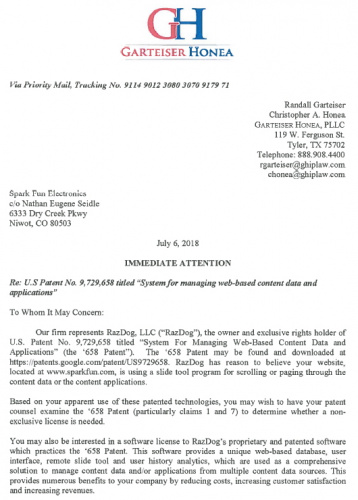

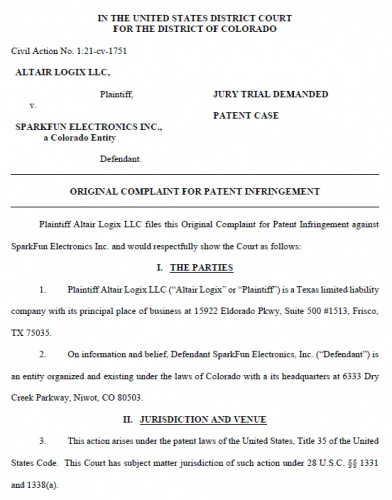
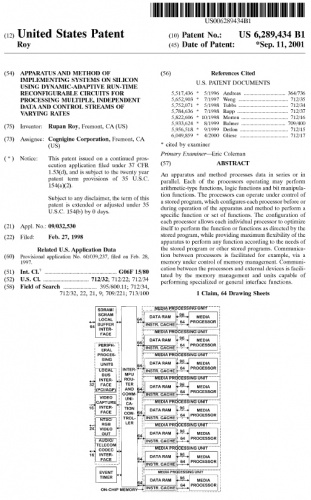
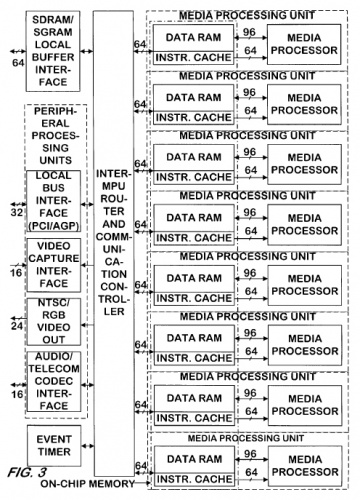
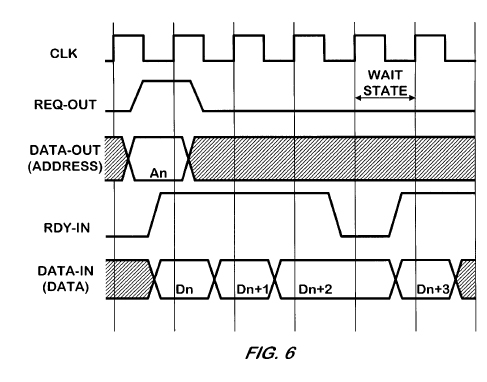
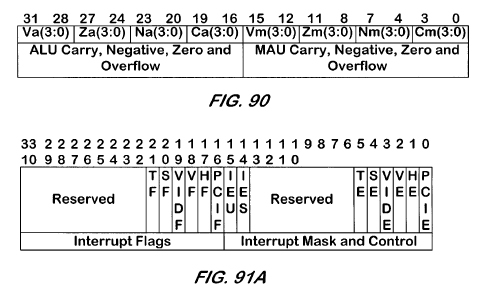






Nate, I'm not in favor of patent trolls either. But there are points in your blog post that are off base.
As I read the patent, it is concerned with hardware architecture. It is not an attempt to patent malloc(). allocation routines. The paragraph you said succinctly describes malloc() actually doesn't. The paragraph is referring to re-configuring the hardware elements via memory mapped configuration elements (vs re-configuration via ports in a separate IO space, or reconfigurable via flash memory which can't be rewritten as quickly).
You say
I looked through the patent, and on page 72 of the PDF, it explains that each MPU (media processing units, of which the processor the patent is describing has 8) "has a 32 bit Multiplier fused with a 32 bit Arithmetic Unit that can accumulate up to 64 bits (the MAU), a 32 bit Arithmetic Logic Unit (the ALU), and a 32 bit Bit Manipulation Unit with a 32 bit Barrel Shifter (the BMU)."
So they do define what the MAU is, and make it clear that it is an element in addition to the ALU and several other elements. So it isn't just wrapping the term ALU in different jargon.
Nor is what the patent is describing just "variable length arrays". Your statement that
is way off base and incorrect, conflating hardware and software. There is a huge difference between a malloc() call and a pipelined processor.
As Member #1686931 said, the patent specifically mentions systems on silicon, so it would seem that the extent of similarities between the Freescale i.MX6 SoC and the processor described in the patent would determine the patent's applicability, and the chip manufacturer may be the more appropriate target. But I'm not a patent lawyer.
I'm not saying the patent is well written, nor passing judgement on whether it should have ever been issued, nor whether the i.MX6 SoC falls within the patent's scope. But if you are going to argue something, argue it on accurate grounds.
I think the "MAU" refers to a Multiply-Accumulate Unit, which is more commonly abbreviated as a "MAC". That type of design goes back a long time:
https://en.wikipedia.org/wiki/Multiply%E2%80%93accumulate_operation
I have no doubt you will win this case. Unfortunately not without some headaches and loss of sleep. These sorry people think they can just toss a bunch of technical jargon around in hopes you will just settle with them to avoid a dogfight in court. Bring some beer and fight like hell! I am going to follow this for sure to see the outcome.
Usual disclaimers, I am not a lawyer, etc, but I do deal with patents occasionally for work. This is hugely simplified, of course.
As this is a post-1995 US patent, it has a term of 20 years, which appears to be expired. Depending on age and jurisdiction, patents can last up to 28 years, so it's always worth checking.
Anyway, you can skip 92 of the 93 pages on this one. To determine infringement, the ONLY thing that matters are the claims (on the last page here, but can be elsewhere). This one only has one claim, so it's easy. Your product needs to do EVERYTHING in that claim to infringe. If there are multiple claims, they'll be arranged in a hierarchy ("the apparatus according to claim X, in which..."), and you need to do everything in one of the independent claims (root nodes, in CS terms) to infringe. Dependent claims are important in the application process, but not too significant once the patent is granted.
While all the stuff about malloc is amusing, they aren't actually trying to patent that. The detailed description (and this is an impressively long one) counts as prior art if you're trying to invalidate a later patent or apply for your own, but is irrelevant for determining infringement. It can be used to clarify terms used in the claims, usually when defending against it. Prior art can invalidate a patent if it describes an entire independent claim, but prior art for something in the description doesn't matter.
Anyway, the actual claim here is for a multiprocessor system with some kind of shared memory, with certain specific modules of each processor able to run concurrently. It might apply to the system you used if it has more than one core ("plurality" in patentese is explicitly more than one), but probably not. If they haven't sued at least Intel, AMD and nVidia, and won or reached a big settlement, it's probably too narrow to apply to any processor that wasn't designed by Cognigine (the original owners, who do appear to be a real company with products) themselves. The architecture they describe looks a lot more like a modern graphics card than a CPU or microcontroller, but given Cognigine's business, it was probably designed for networking.
As for whether it was ever valid? 1998 was way before modern multi-core CPUs, and about the time early consumer 3D graphics cards came out, so it was probably novel and non-obvious back then.
Incidentally, the fact that there is only one claim is also a hint that this is a really narrow patent. Patents are often drafted with a big hierarchy of claims, mostly non-novel, in the hope of getting broad coverage. As part of the application process, claims get combined until each independent claim is novel in itself (this can take years). If the entire tree got collapsed into one claim, then there's probably only one tiny detail in that claim that is actually novel. Or rather, was actually novel in 1998.
Multi-core SMP CPUs go back well before 1998. I worked on such a system in 1993 and it was a follow-on product from a previous generation SMP system. https://en.wikipedia.org/wiki/Symmetric_multiprocessing
Hi Nate,
Disclaimer: I'm retired from IBM and do not speak for IBM. My opinions are my own. This is not an advertisement for IBM services or an endorsement, but rather just information about one way to combat patent trolls.
Patent trolls are a serious inhibitor to businesses.
IBM maintains a large portfolios of patents which it licenses and indemnifies as a service to other companies. IBM will legally defend these patents vigorously. A troll suing on a spurious web patent is usually infringing on several earlier IBM patents and other corporate patents that expired years ago. IBM also supports and defends Open Source.
For more information, IBM's website for Intellectual Property Licensing is here:
https://www.ibm.com/legal/licensing
The following is solely an expression of my personal opinion and not IBM: I have worked with IBM IPL lawyers at various times during my career at IBM, and in my own opinion IBM lawyers deserve their reputation as "The Nazguls". They are magnificent bastards. I personally know of two patent troll cases that IBM defended dismissed by a judge with prejudice, which is the judicial equivalent of a pimp slap.
I second your plug for EFF -- they are a wonderful organization.
Speaking as an attorney and professor of patent law, I respect how much courage it takes for you to stand up and shine the spotlight on these trolls. Even though you expressed it, I doubt most people can relate to just how unnerving (and brave) it is to go public when you are being bullied, when the seemingly safest course is to lay low and wait for the bullies to go away. By speaking up, you speak for not only yourself, but also for thousands of other businesses who deal with trolls every day yet lack the platform or leverage to do anything about it. Bravo!
I want to caution you and your readers, though, that the one thing you should not do is completely ignore these threat letters. As annoying as these letters are, and as much as you might want to shred/burn them for catharsis, willfully ignoring a notice could actually expose you to increased liability down the road. The better course, as annoying as it may be, is to forward these threats to your own patent attorney, who can provide you with a full assessment of the (total lack of) merit behind these claims, for only a few hours of attorney time. That is actually the lowest-risk, most cost-effective thing you can do in this situation. It will allow you to rest easy knowing the claims truly have no merit, and it can insulate you against any future claim of willfully ignoring the notice.
This is a self-serving reply, because I support EFF and personally specialize in invalidating bad patents and defending companies against patent trolls, and I am not your lawyer. So give whatever weight you wish to my advice to seek counsel. But if you decide that you do want help, or if you know anyone else being victimized by trolls, you can message me any time.
Keep up the good fight.
I'm not a lawyer, nor do I play one on TV, not even a Patent Lawyer, but I am familiar with malloc() -- Wikipedia has an article that talks about dynamic allocation of memory (please note that this is distinct from dynamic RAM, although it can be applied to any form of RAM). The article states that malloc() first appeared in Bell Labs Unix Version 7, back in 1979. Corroborating evidence can be found in "The C Programming Language", second edition, by Brian W. Kernighan and Dennis M. Ritchie, Copyright © 1988, 1978 by Bell Telephone Laboratories, Incorporated.
In any event, if the patent in question does indeed describe the functionality of malloc(), then the patent is invalid due to "prior art".
Could one patent the business method of "patent trolling" and then sue the patent trolls?
Just asking for a friend who lives under a bridge.
Wouldn't the term "SYSTEMS ON SILICON" aka SoC mean the scope of the patent is limited to the IC manufacturer, rather than the implementor of an IC? I'm pretty certain there was no custom IC's on that pcDuino board?
The term "System on Silicon" does not appear in the language of the only claim allowed. Any potential infringement is evaluated based on the language of the allowed claims.
Unfortunately the 3 digit abbreviation is not something that AI independently came up with ;;; It's the standardized abbreviation for patents that every single patent attorney and agent in the entire US uses. If you end up getting an attorney on this case, your own attorney will also be using those same abbreviations.
Hi Nate, I'm very sorry to hear that Altair Logix is bothering you. You might be interested in checking out RPX at rpxcorp.com, we deal with this all the time, help our members avoid these headaches, and help take care of them when they do come up. We're not a law firm; we have a different and innovative way of dealing with this. No hard sell here, just let me know if you're interested in finding out more.
Way to go! Trolls live in the shadows and under bridges. They die in the light of day!
I'm amused at their "demand" for a jury trial. Jury trials are an expensive, complicated mess, and one that's hard to control the outcome. If such a thing came to pass (and I strongly suspect they would strenuously avoid an actual jury trial), you could get a lot of mileage from the "evil patent troll trying to smash a friendly small business" approach (which has the strong advantage of being true). I'm also unsure if you can "demand" a jury trial in an initial suit. If it did come to that, I would willingly sit on the jury, but (of course) it doesn't work that way. I salute companies like SparkFun and NewEgg who take on these clowns (NewEgg even pursues rulings when the trolls realize they're outmatched and try to get the cases dismissed: by doing so, they can make the invalidity of the trolls' claims a matter of legal record, hamstringing their ability to sue anybody else).
Yeah, the US patent system is in shambles. I'm going through one right now (for a music notation, not hardware or software), and you can't even text-search them prior to like 1975. There's no unified way to represent or name things, so searching software or even electrical circuit patents is a nightmare. Compared to science and engineering, patenting is so backwards. A compiler can tell if I worded everything correctly in minutes, and some automated tests can tell me if it actually works. Then you fix. it's similar to the scientific / engineering process of guess and test and fix. But with patents, you write everything, then it sits on a shelf for 1.5 years. Then an examiner gives an opinion. And if you made a mistake, it's over; no do-overs. But you don't know if it really holds up until you fight it in a court battle, and then again on appeal and win. And, lol I used to live on the north side of Dallas, where that bad district is with the judge who helps that big patent trolling organization, and there was an Apple store on my side of town, and Apple closed it so that they had no operations in the district where that company is. This is why we can't have nice things. But I feel for you; because as someone desperately trying to make it in a start up business, a patent attorney can suck your funds dry real fast. I have to be very careful what I engage mine to do.
Nah, you'll be fine. Most patents aren't even able to hold up in court and have no real legal standing when really put up to a magnifying glass. I think they know this.
Few people are awarded patents these days at all, and even fewer can use them to actually defend an idea and product. That's why there are so many "patent pending" products out there. Most are not even applying for a patent.
They are solely relying on you to feel the sweat and settle out of court. The problem is they keep getting money because people keep giving in because of fear so they do settle. And they keep doing it because it works.
You are right that "media processor" might have been able to be defensible in 1998, but today no reasonable judge would think so.
If it does indeed go to Colorado court I would indeed bring a beer. Good luck and keep up the good fight!
“Dynamic ram? Can I poke fun at them for not knowing what RAM is? Yes I can”
Sadly you can’t poke fun of them on this point. In this context Static and Dynamic refer to the kind of RAM hardware. Dynamic RAM requires external refresh circuitry. Static RAM does not.
Sorry, my joke fell a little flat. I was criticizing their poor use of capital letters for an acronym (Random Access Memory, not ram as in sheep).
What makes this terribly sad is the fact that two presidents reduced tge patent system to trash and jacked up health care costs to unaffordable with the stroke of a pen. The other eliminated patent agents and made the patent club for lawyers only. This lawsuit has frivolous writren all over it.
What POTUS eliminated the "Registered Patent Agent"? As of this date, there are 12,772 active Patent Agents registered with the USPTO. My Registration to Practice is still active.